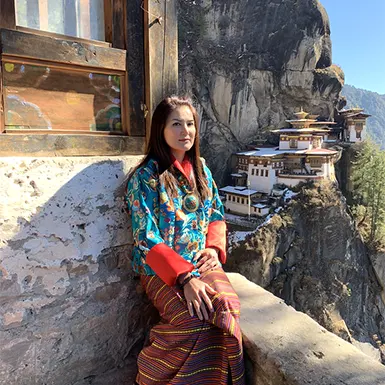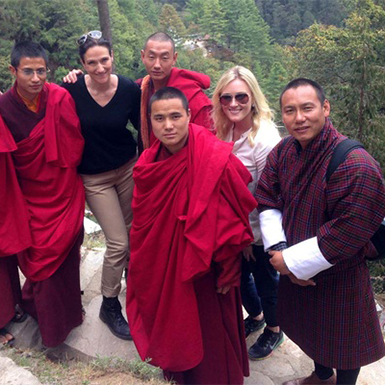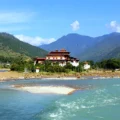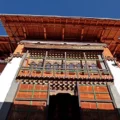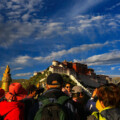Kyichu Lhakhang, nestled in the majestic Paro Valley of Bhutan, is a historic temple revered as one of the country’s most sacred sites. As a living testament to Bhutan’s rich Buddhist heritage, Kyerchu Temple dates back to the 7th century and attracts countless devotees as a critical pilgrimage destination. It is more than just a structure.
A Beacon of Buddhism
Kyichu Lhakhang’s significance is multifaceted. Believed to be one of the oldest temples in Bhutan, it was allegedly constructed by the 33rd Tibetan King, Songtsen Gampo, in the 7th century. Legend tells of 108 temples built across Tibet and the Himalayas on the same day, with Kyichu Lhakhang strategically placed to subdue a mythical demoness and pave the way for the spread of Buddhism.
Over the centuries, Kyerchu Temple has witnessed the footsteps of revered Buddhist figures like Guru Padmasambhava, who is said to have blessed the temple and hidden spiritual treasures within its walls. Today, the temple complex comprises two distinct structures – the Jowo Lhakhang, the older temple, and a newer one built in the 19th century.
A Spiritual Haven
A visit to Kyichu Lhakhang transcends religious affiliation. The tranquility of the surroundings, the intricate Buddhist iconography adorning the walls, and the palpable reverence of devotees all combine to create a truly spiritual atmosphere. Here’s what you can expect during your visit:
- Jowo Lhakhang: Believed to house a statue of the young Buddha, the Jowo Lhakhang is the heart of the temple complex.
- Second Temple: This newer structure offers a contrasting yet harmonious architectural style and houses additional religious relics.
- Prayer Wheels: Dotting the temple grounds is a cornerstone of Buddhist practice. Devotees spin these wheels while chanting mantras, accumulating merit.
- Surrounding Landscape: The serene beauty of the Paro Valley adds to Kyichu Lhakhang’s spiritual aura. Take a moment to soak in the breathtaking mountain vistas.
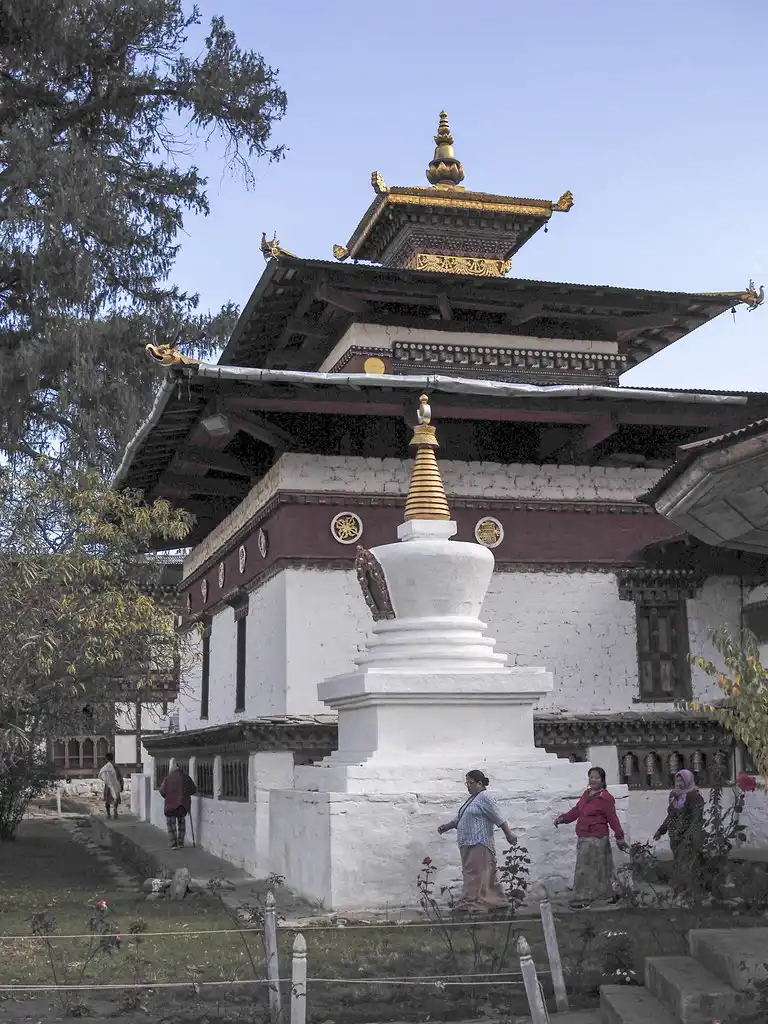
Kyichu Lhakhang: Where Legends and Royalty Converge
The story of Kyichu Lhakhang unfolds like a captivating legend intertwined with the spread of Buddhism throughout the Himalayas. In the 7th century, the devout Tibetan King Songtsen Gampo, eager to share his faith, sought to expand Buddhism’s reach across the region.
Overcoming the Demoness: A Temple’s Divine Purpose
Legend has it that a colossal demoness obstructed Songtsen Gampo’s mission, hindering the growth of Buddhist teachings. But the resourceful king devised a clever plan. He envisioned building 108 temples strategically placed to subdue the demoness’s power. Kyerchu Temple, constructed in 659 CE, is said to have been built on her left foot, forever anchoring her to the earth and clearing the path for Buddhism to flourish.
Guru Rinpoche’s Sacred Blessing
Centuries later, in the 8th century, the esteemed Buddhist master Guru Rinpoche (Padmasambhava) graced Kyichu Lhakhang with his presence. Renowned for his profound wisdom and spiritual abilities, Guru Rinpoche reportedly hid sacred treasures (terma) within the temple grounds and surrounding landscape, imbuing the site with immense spiritual power.
A Legacy of Royal Guardianship and Renewal
Over the centuries, Bhutan’s monarchs have cherished and protected Kyichu Lhakhang, recognizing its profound importance. They actively commissioned renovations and expansions, ensuring the temple’s continued magnificence and structural integrity.
Notable Patrons
- King Sindhu Raja (8th century): The king enlarged the original structure and adorned it with treasured religious artifacts and precious offerings.
- Tenth Desi Mipham Wangpo (17th century): This influential figure oversaw the construction of a new assembly hall and commissioned the creation of breathtaking murals that continue to adorn the temple’s walls.
- King Jigme Dorji Wangchuck (20th century) initiated extensive restoration efforts, carefully preserving the temple’s ancient character while strengthening its foundations for future generations.
A Living Link to Bhutan’s Spiritual Heart
Today, Kyichu Lhakhang remains a vibrant testament to Bhutan’s enduring devotion to Buddhism. The temple’s walls whisper stories of ancient legends, royal patronage, and the unwavering faith of countless pilgrims seeking solace and inspiration within its sacred walls. Stepping inside Kyerchu Temple is like stepping back in time. The vibrant murals, intricate woodwork, and air of serenity envelop visitors, offering a profound window into the heart of Bhutanese spirituality.
Architectural Masterpiece of Bhutanese Heritage
Kyichu Lhakhang is a testament to Bhutan’s rich artistic and spiritual traditions. Its architecture, a harmonious blend of form and function, is a visual feast for visitors. Let’s explore the intricate details that make this temple a true gem:
A Symphony of Wood, Stone, and Color
Approaching Kyichu Lhakhang, you’ll be captivated by the intricate woodwork that graces its exterior. Elaborate carvings depict auspicious symbols, mythical creatures like dragons and phoenixes, and scenes from Buddhist teachings. The temple’s vibrant colors, a hallmark of Bhutanese architecture, create a sense of joy and celebration. Inside, the walls come alive with elaborate murals illustrating deities, historical events, and spiritual stories, each brushstroke showcasing the region’s rich artistic heritage.
The Sacred Heart of Kyichu Lhakhang: Jowo Sakyamuni
The focal point of the main temple (Lhakhang) is the revered statue of Jowo Shakyamuni, the historical Buddha. This sacred effigy, cast in bronze and adorned with precious jewels, exudes a sense of profound serenity and wisdom. Devotees and visitors have sought blessings and inspiration from this central figure for centuries.
The Ever-Bearing Orange Tree: A Symbol of Eternal Life
A unique and enchanting feature of Kyerchu Temple is the orange tree that thrives within its courtyard. According to legend, Guru Rinpoche, the great Buddhist master, planted this tree. Remarkably, it is said to bear fruit all year round, symbolizing the temple’s enduring spiritual vitality and the continuous cycle of life, death, and rebirth.
Architectural Highlights
- Guru Lhakhang: A secondary temple dedicated to Guru Rinpoche, featuring a majestic statue of the guru and intricate wall paintings depicting his life and teachings.
- Prayer Wheels: Rows of prayer wheels encircle the temple, inviting visitors to participate in the ancient practice of turning them to accumulate merit and send prayers out into the world.
- Golden Roof: The main temple boasts a resplendent golden roof, a signature element of Bhutanese religious architecture that signifies the space’s sacred nature.
- Tranquil Courtyards: Peaceful courtyards provide spaces for quiet reflection and meditation, enveloped by the natural beauty of the surrounding landscape.
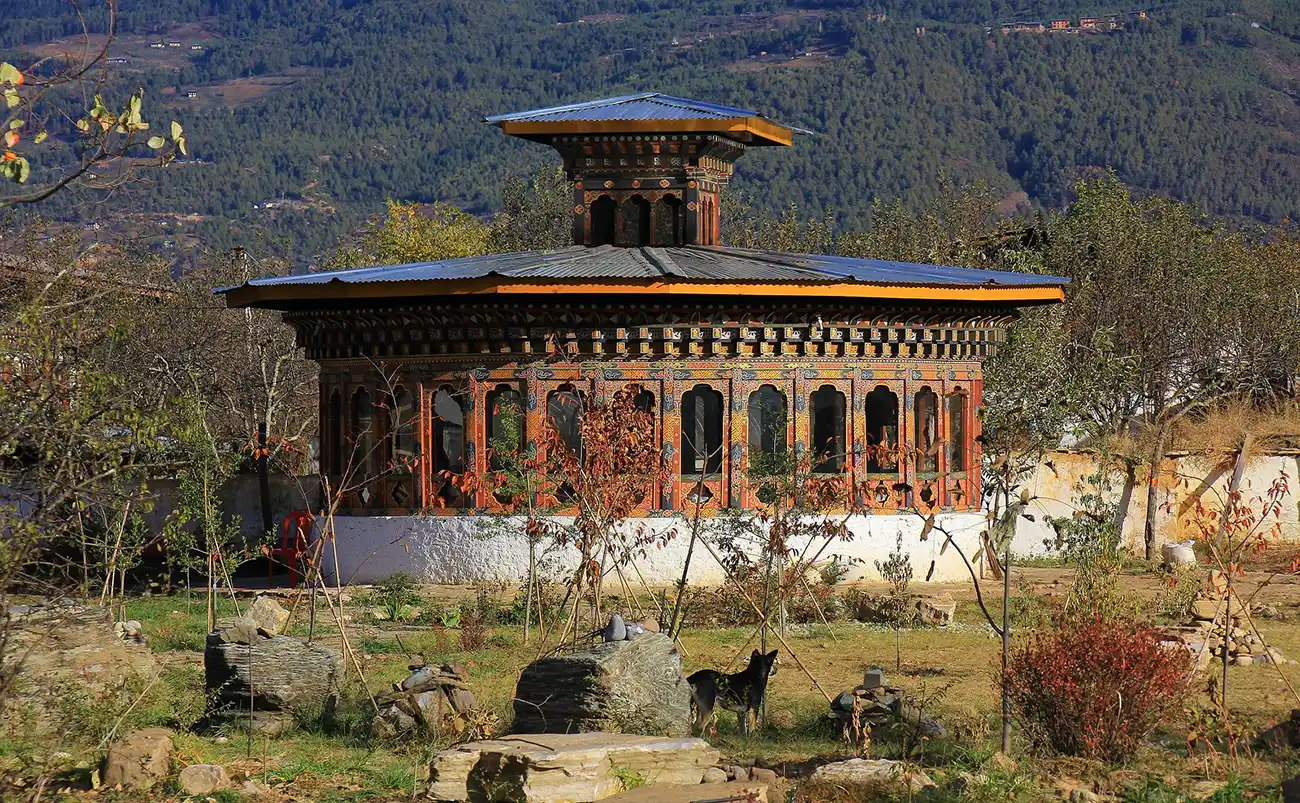
Bhutan’s Spiritual Heartbeat and Cultural Gem
Kyichu Lhakhang isn’t just a historical landmark; it’s a vibrant hub of Bhutanese Buddhism and a place of deep spiritual resonance. Let’s explore its significance in the lives of locals and pilgrims alike.
A Cornerstone of Bhutanese Buddhism
It holds a special place in the heart of Bhutan’s Vajrayana Buddhist tradition. Believed to radiate potent spiritual energy, it draws countless devotees seeking blessings, comfort, and enlightenment. Visitors often witness locals and fellow travelers circumambulating the temple, spinning prayer wheels, and offering butter lamps as heartfelt gestures of devotion.
Festivals: A Tapestry of Faith and Tradition
Kyichu Lhakhang comes alive during its vibrant festivals, showcasing Bhutan’s rich cultural heritage. These events provide a window into the heart of local culture, showcasing customs, beliefs, and artistic traditions. Key Festivals at Kyerchu Temple:
- Paro Tshechu: This annual spectacle, typically held in spring, features mesmerizing masked dances, sacred ceremonies, and a joyous atmosphere that attracts crowds of locals and tourists.
- Thangka Display: On special occasions, lamas unveil enormous religious scroll paintings known as thangkas for public viewing. These intricate works of art depict Buddhist deities and teachings, providing a unique window into Bhutanese iconography.
- Other Religious Events: Kyichu Lhakhang hosts various smaller festivals and ceremonies throughout the year, honoring essential dates in the Buddhist calendar and offering further opportunities for cultural immersion.
Blessings and Rituals: Nourishing the Spirit
Seeking blessings and spiritual merit, pilgrims tour Kyichu Lhakhang to participate in time-honored rituals that promote well-being. The temple’s monks, or lamas, offer prayers, perform ceremonies, and guide those seeking a deeper connection with their faith.
Standard Practices at Kyichu Lhakhang:
- Lighting Butter Lamps: Devotees light butter lamps as a symbol of devotion, their flickering flames illuminating the path to enlightenment.
- Reciting Prayers: The rhythmic chanting of mantras and prayers fills the air, creating an atmosphere of peace and focus.
- Receiving Blessings: Pilgrims often receive blessings from the lamas, who use holy water or sacred threads believed to offer protection and good fortune.
A Sanctuary of Peace and Reflection
It provides a serene sanctuary away from the demands of daily life. Its tranquil atmosphere, steeped in history and spirituality, encourages visitors to slow down, reflect, and connect with something more profound. Whether you are a devout Buddhist or seek solace and inspiration, Kyerchu Temple welcomes you with open arms.
Experience the Magic of Kyichu Lhakhang: A Visitor’s Guide
Visiting Kyichu Lhakhang is not just about seeing; it’s about feeling. It’s a chance to step back in time, connect with Bhutanese culture, and begin a tour of personal reflection. Let’s uncover the enriching experiences that await you:
Guided Tours: Uncover Hidden Treasures
Take a guided tour to explore the heart of Kyichu Lhakhang. Knowledgeable guides will share captivating stories about the temple’s rich history, intricate architecture, and spiritual significance. You’ll leave with a newfound appreciation for this cherished Bhutanese treasure.
Wander Through Sacred Grounds: A Feast for the Senses
- Courtyards: As you walk through the tranquil courtyards, feel the gentle sway of colorful prayer flags and admire the traditional Bhutanese architecture. The intricate woodwork and vibrant hues create a peaceful atmosphere that invites relaxation and introspection.
- Prayer Wheels: Gently spin the rows of prayer wheels that line the pathways. Each turn sends out mantras, adding your positive energy to the sacred space.
- Smaller Chapels (Lhakhangs): Explore these intimate spaces, each a unique treasure trove of Buddhist art and artifacts—Marvel at the diverse statues, murals, and offerings that adorn the walls and altars.
- The Sacred Orange Tree: Behold the legendary orange tree in the central courtyard. Its year-round fruit symbolizes enduring spiritual vitality. Legend says Guru Rinpoche planted this tree, adding to its mystical allure.
Participate in Spiritual Practices: Nourish Your Soul
Kyichu Lhakhang offers more than just passive observation. You can actively engage in the temple’s spiritual life through:
- Prayer Sessions: Join the resident monks as they chant ancient mantras. Surrender to the rhythmic sounds and pulsating energy of collective devotion.
- Blessings: Receive a personal blessing from one of the monks, a simple yet profound ritual believed to bestow good fortune and protection.
- Meditation: Find a quiet spot on the temple grounds to meditate. Let the tranquil atmosphere guide you into mindfulness and inner peace.
- Festivals (Tsechu): If you’re fortunate enough to visit during a festival, you’ll witness a vibrant display of Bhutanese culture through masked dances, religious ceremonies, and joyous celebrations.

Visitors Share Their Experiences
- “The prayer session at Kyichu Lhakhang was a truly emotional experience. The monks’ chanting and the flickering butter lamps filled the air with a sense of reverence and peace.” – Dorji, a visitor from Bhutan.
- “Receiving a blessing from the monk was a highlight of my trip. It was a simple gesture, but it felt so meaningful and personal.” – Anya, a traveler from Russia.
Plan Your Visit to Kyichu Lhakhang
- Hours: Kyichu Lhakhang is typically open daily from 9:00 AM to 5:00 PM.
- Dress Code: Dress modestly by covering your shoulders and knees to show respect for this sacred site.
- Photography: Please note that the temple authorities may restrict photography inside the main temple building. Always ask for permission before taking pictures.
Finding Kyichu Lhakhang: A Spiritual Haven in Paro Valley
Tucked away in the scenic Paro Valley, Kyichu Lhakhang is a gem accessible from Paro. It’s a convenient addition to any Bhutan travel itinerary. Here’s how to find this sacred site:
Getting to Kyichu Lhakhang
- From Paro Town: Kyichu Lhakhang is a mere 5 kilometers (3 miles) from Paro Town. You can easily reach it by taxi in under 15 minutes. Enjoy a picturesque walk that takes 30-45 minutes for a more scenic route.
- From Paro International Airport: The temple is closer to the airport, approximately 4 kilometers (2.5 miles) away. A taxi will get you there in about 10 minutes.
Transportation Options: Your Choice
- Taxi: Taxis are readily available in Paro and provide a comfortable and efficient way to reach Kyichu Lhakhang.
- Walking: If you enjoy a stroll and want to soak in the scenery, consider walking to the temple. The route is well-marked and winds through the scenic Paro Valley.
- Bus: Public buses also operate between Paro Town and Kyichu Lhakhang, offering a budget-friendly alternative for travelers.
Discover Paro’s Enchanting Attractions Beyond Kyichu Lhakhang
Anchored by the sacred Kyichu Lhakhang, Paro Valley unfolds as a tapestry of cultural and natural wonders, promising an experience that stirs the soul. Let’s unveil some of these gems and craft unforgettable itineraries for your Bhutan adventure.
Must-See Stops Near Kyichu Lhakhang
- Paro Taktsang (Tiger’s Nest Monastery): A true Bhutanese icon, this sacred monastery clings dramatically to a cliffside, promising breathtaking views and a challenging yet rewarding hike. It is spiritual energy, and architectural beauty will leave you in awe.
- Drukgyel Dzong: Step back in time as you explore the ruins of this historic fortress. Once a guardian against Tibetan invasions, it now whispers stories of bravery and strategic triumphs, its weathered walls a testament to Bhutan’s rich past.
- Rinpung Dzong (Paro Dzong): This magnificent fortress complex dominates the Paro skyline and serves as the administrative and monastic center of the valley. Wander through its intricate courtyards, admire its temples, and discover the fascinating world of Bhutanese governance and spirituality.
- National Museum of Bhutan: Housed in a former watchtower above Rinpung Dzong, this museum invites you to dive into Bhutan’s cultural heritage. You’ll encounter ancient artifacts, exquisite textiles, and sacred religious art that reveal the nation’s unique identity.
- Ta Dzong: Climb to the top of this distinctive circular building, once a watchtower and now home to the National Museum. Take in the panoramic views of the Paro Valley and let the majestic Himalayas take your breath away.
- Paro Weekend Market: Experience the vibrant pulse of local life at this bustling market. Savor traditional Bhutanese snacks, bargain for unique souvenirs, and chat with friendly vendors as you soak up the lively atmosphere.
Suggested Itineraries for an Enriching Paro Experience:
One-Day Adventure
- Morning: Begin your day with a visit to the serene Kyichu Lhakhang, where you can explore its rich history and soak in the spiritual ambiance.
- Afternoon: Head to Rinpung Dzong to explore its architectural wonders and learn about Bhutan’s unique political and religious traditions.
Two-Day Cultural Exploration
- Day 1: Discover the treasures of Kyichu Lhakhang and the nearby Druk Choeding Temple, known for its peaceful atmosphere and beautiful murals.
- Day 2: Begin on the unforgettable hike to Paro Taktsang (Tiger’s Nest Monastery). Challenge yourself physically and be rewarded with spiritual enlightenment and breathtaking views.
Three-Day Paro Immersion
- Day 1: Visit Kyichu Lhakhang and Druk Choeding Temple, followed by a relaxing afternoon strolling through the charming streets of Paro Town.
- Day 2: Hike to Paro Taktsang, allowing yourself to be captivated by its spiritual energy and scenic vistas.
- Day 3: Explore Rinpung Dzong and the National Museum, and unwind with a traditional Bhutanese hot stone bath for the ultimate relaxation and rejuvenation.
Practical Tips for a Memorable Visit
Planning a trip to Kyichu Lhakhang? Let’s make it a breeze with these helpful tips:
Choosing the Perfect Time to Visit
- Optimal Seasons: Embrace the mild temperatures and clear skies of spring (March-May) or fall (September-November). Pleasant weather makes these seasons ideal for both temple visits and exploring the beauty of the surrounding landscape. Plus, spring brings the vibrant Paro Tshechu festival!
- Weather Wisdom: Plan your visit outside the monsoon season (June-August). Heavy rains can make travel difficult and hinder your exploration. If you’re sensitive to the cold, remember that winters (December-February) can get chilly, especially at higher altitudes.
Pack Smart: Essentials for Your Bhutanese Adventure
- Dress Respectfully: Respect the sacred temple by packing clothes covering your shoulders and knees. Wear comfortable walking shoes for strolling around the temple grounds and nearby attractions.
- Sun & Rain Protection: Be aware of cooler temperatures! Bhutan’s sun packs a punch, so pack a hat, sunglasses, and sunscreen for year-round sun protection.
- Capture the Moments: Bring your camera! Although photography inside the main temple is restricted, you’ll want to capture the breathtaking architecture, vibrant festivals, and serene atmosphere.
- Cash on Hand: Bring some Bhutanese Ngultrum (BTN) for entrance fees, donations, and shopping for unique souvenirs.
Cultural Etiquette: Navigate with Respect
- Leave Your Shoes at the Door: Show respect for the sacred space by removing your shoes before entering any temple building.
- Mindful Photography: Be aware of photography restrictions, especially inside the main temple. Always ask for permission before taking photos.
- Spin the Prayer Wheels: Gently spin the prayer wheels clockwise as you walk around the temple. This beautiful tradition sends out prayers and positive energy.
- Offer a Small Gift: Consider making a small donation to help support the temple and its upkeep.
- Embrace the Quiet: Maintain a peaceful atmosphere by speaking softly and avoiding disruptive behavior.
- Walk Clockwise: Always walk around the temple clockwise, keeping the temple on your right side.
Local Tip from Tashi, a Bhutanese local
“I always recommend dressing in layers, as the temperature can change throughout the day. And make sure to charge your camera – you’ll want to capture every moment of the beauty at Kyichu Lhakhang!”
Your Gateway to Bhutan’s Timeless Spirit
Kyichu Lhakhang isn’t just a temple; it’s a tour through Bhutan’s rich spiritual and cultural heritage. Ancient legends whisper from its hallowed halls, and vibrant murals and intricate woodwork depict Bhutanese devotion and artistry.
Key Takeaways
- Ancient Origins: Kyichu Lhakhang, one of Bhutan’s oldest temples, dates back to the 7th century. Its walls echo over 1,300 years of history.
- Spiritual Significance: Discover the legend of its founding – a tale of a demoness subdued, paving the way for Buddhism to flourish. Feel the mystical energy that permeates the sacred grounds.
- Architectural Marvel: The traditional Bhutanese design captivates with intricate woodwork, colorful murals, and unique features like the ever-bearing orange tree. Each detail whispers a story of faith and creativity.
- Cultural Hub: Kyichu Lhakhang is a vibrant center for Bhutanese Buddhism. It hosts colorful festivals and offers opportunities for spiritual practices that nourish the soul.
- Visitor Experience: Whether you choose a guided tour to delve into the temple’s history or seek a quiet corner for reflection, Kyichu Lhakhang offers an enriching experience for every visitor.
An Invitation to Bhutan’s Sacred Valley
Let Kyichu Lhakhang be your starting point for exploring the wonders of Paro Valley. Stroll through tranquil courtyards, spin prayer wheels, and perhaps witness the vibrant Paro Tshechu festival. Venture further to the awe-inspiring Paro Taktsang (Tiger’s Nest Monastery) or the majestic Rinpung Dzong.

